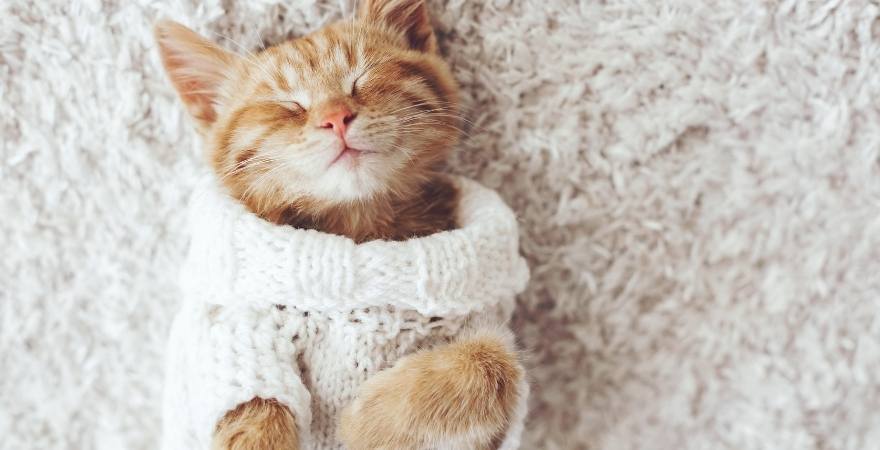Hairballs and cats go hand in hand (or should we say ‘paw in paw’?!). A hairball is composed of tightly packed fur as well as saliva and food particles. Cats will vomit up hairballs every now and then. It can be unsettling to hear the loud, retching noise that they make. You may even wonder if they are choking. Rest assured though, once the hairball has been brought up, they will be feeling right as rain again.
Beware not to fall into the trap of thinking that every retch and cough is a hairball. If your cat is gagging but nothing is coming up, there may be more going on. Diseases like asthma and pneumonia can be confused with hairballs, so have a chat with your vet if unsure.
While you may expect your kitty to spit out any fur it gets in its mouth, this isn’t easy for them. The reason is that their tongue is covered in barbs. These ‘spines’ are what make your cat’s tongue feel like sandpaper. They also create a ‘one way system’ making spitting fur out really tricky for them.
A rose by any other name...
The ‘nerdy name’ for a hairball is a trichobezoar. ‘Trich’ means hair, while ‘bezoar’ refers to the fact that the mass was in the gastrointestinal tract. Now there’s a fact to impress your friends with the next time you see them!
Hairballs are not actually balls
Don’t be fooled into thinking a hairball is a nice, round shape. Most are cylinders; the same shape as your cat’s food pipe. Some describe them as a ‘cigar’, while others say they are ‘sausage’ shaped. Somehow, we think the word ‘hairball’ has a nicer ring to it than ‘hair-sausage!’.
When they are brought up, they are generally covered in a film of saliva. They are slimy and certainly unappealing. Some may mistake them for poop but they will have a different smell and texture.
Hairballs are usually normal
A cat that keeps themselves clean and well-groomed is a healthy cat. In fact, when your cat stops grooming, this can be a sign they are under the weather. A hair ball every few weeks or so means your kitty is grooming well. You may find they produce more hairballs when they are shedding more. Similarly, if you are brushing them less, there will be more dead fur to be swallowed.
A sudden uptick in hairballs is something we should pay attention to. This may indicate an issue such as dermatitis. If your cat is itchy or irritated, the extra licking can lead to bald spots and more hairballs.
Less commonly, hairballs can be problematic. There are case studies of cats who have developed digestive obstructions due to hairballs.
What you see isn’t always the full story
Inevitably, your cat will be grooming off and consuming A LOT more fur than what we see. Most of the time, this fur is passed out through the digestive system. We may see some of the fur in the stool, though often it is mixed in well.
Hairballs will feature more heavily at certain times of the year
You may have already noticed a pattern. Does Felix tend to bring up more fur balls in the spring and summer? This is the norm. The reason for this is that the more a cat sheds, the more fur they have to deal with when grooming. Nature is clever and when the weather warms up, cats lose their fur more quickly to help keep them cool.
It’s worth saying that indoor cats will shed a lot in the winter too. The reason? Our creature comforts of course. We humans dislike being too cold and tend to have the central heating on when it’s chilly outside. A cat can misinterpret this to mean it is Springtime; time to moult!
Some cats will produce more hairballs than others
Try not to compare your cat to Garfield down the road. While their cat may never bring up furballs, this doesn’t mean you should expect the same from yours.
Frequency of fur balls will depend on several factors including:
- Age
- Skin and fur health
- Whether your cat is a regular groomer or not
- Diet
If your cat suddenly stops grooming, you may notice mats and a lack of hair balls. Causes can include dental disease or joint disease. Have a read of our articles on these topics to find out more: Dental disease & Joint disease
Try to gauge what is normal for your feline friend. If you notice they are bringing up more fur balls than usual, this is worth discussing with their vet.
And, if you do want to support your cats skin and coat health (and keep those hairballs at bay - check out our Hairball Be Gone Support Chews)
Dr. Linda Simon, BVMS, MRCVS
Veterinary surgeon,Dr. Linda Simon MVB MRCVS is a locum veterinary surgeon who has worked in London for the past 8 years. She graduated top of her class in small animal medicine from UCD, Dublin. She is currently a member of the Royal College of Veterinary Surgeons.




